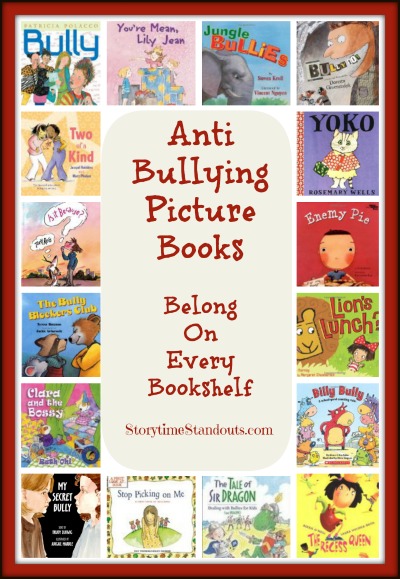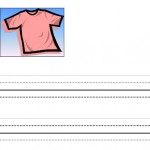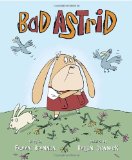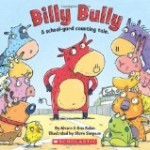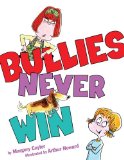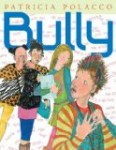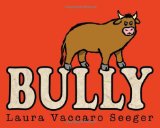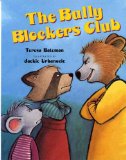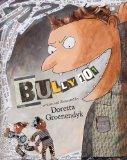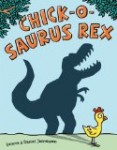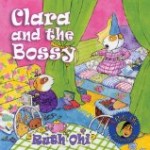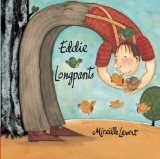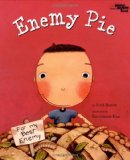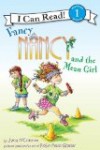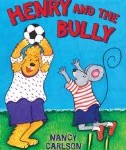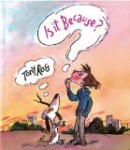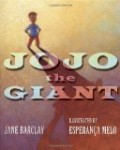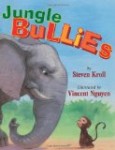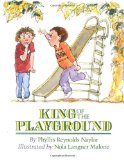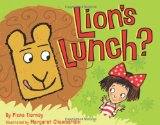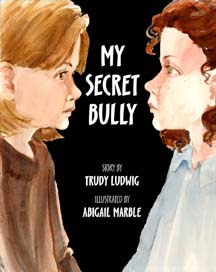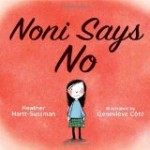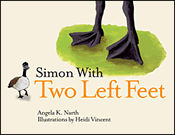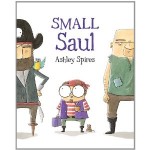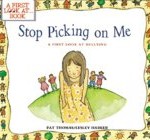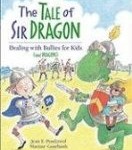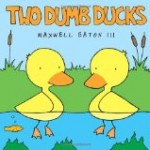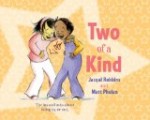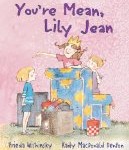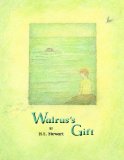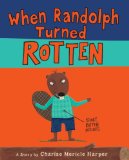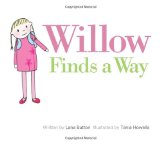Anti-Bullying
Picture books that explore bullying behaviors and conflict resolution themes
Whether a young child is being bullied or is bullying another child, these books and the guidance of a caring adult will help.

When presenting our Celebrating Diversity with Picture Books workshop at conferences, we always include a selection of picture books that effectively convey an anti-bullying message. We make sure that the books explore types of bullying and realistic solutions to bullying.
We hope that our descriptions of these picture books will help teachers and parents choose books that will be age-appropriate and that they will provide helpful ideas about effective ways to deal with bullies, how bystanders can help and other ways to assist a bullied child.
Also on this page
Pink Shirt Day writing paper for kids and our Anti-bullying Pinterest Board
Elsewhere on this site ~
– Anti-Bullying Chapter Books Excellent selection of recommended anti-bullying picture books for home and school. #earlyed #kinderchat #antibullying #kidlit Share on XRecommended Anti-Bullying Picture Books for School and Home
Bad Astrid written by Eileen Brennan and illustrated by Regan Dunnick
Antibullying picture book published by Random House

She came into town like five tons of bad luck.
She came into town in a big moving truck.
From the moment Astrid and her family move into a new neighborhood, she is unpleasant. She chases, teases and is destructive. Ignoring her and keeping busy seems to be the best solution until one day Astrid has a bad accident while riding her bike. She needs help. Her victim hesitates to step forward. She asks, “Why are you mean to me?”. Astrid’s explanation surprises her remarkably forgiving neighbor and the two girls discover a way to be friends.
When reviewing antibullying picture books, we prefer stories that resolve the bullying problem realistically. Although Astrid’s bike crash and her victim’s willingness to forgive her past deeds provide a somewhat’magical’ solution to a serious bullying problem, we think there is lots to appreciate about Bad Astrid. Fun cartoon-like illustrations, playful word art and rhyming text will have special appeal for older readers and may make this an excellent discussion-starter about bullying for primary-grade classrooms.
Billy Bully A school-yard counting tale – written by Alvaro and Ana Galan, illustrated by Steve Simpson
Counting book about bullying and friendship published by Scholastic

When Billy Bully arrives at the school playground, his animal friends are already there. Cow is enjoying a swing, horse is on the teeter totter and duck is on the slide. Within moments, Billy Bully has taken charge. He chases the others off the slide, grabs toys and he won’t wait his turn. One by one, he upsets each of his classmates and loses friends.
Eventually Billy Bully discovers that every one of his classmates has run away from him. There is no one to play with.
Now Billy Bully’s feeling blue,
Until – he figures out just what to do.
After counting down his friends, Billy sets to work repairing the harm he has done.
When Billy Bull learns how to play,
all his friends come back to stay.
Best suited to preschool or kindergarten age children, Billy Bully is a rhyming counting book with an important message about bullying and friendship. It includes an Afterword for parents and teachers by Ellen Jacobs, Ph.D., Clinical Social Work
Bullies Never Win written by Margery Cuyler and illustrated by Arthur Howard
Anti-bullying picture book published by Simon and Schuster Books for Young Readers

Jessia and Brenda are in the same first-grade class. In Jessica’s eyes, Brenda is perfect. Her hair is perfect, her homework is perfect and her clothes are perfect. Jessica is a worrier. She is frustrated by her clothing, her knees, her barrettes and making mistakes at school but mostly she is frustrated by Brenda’s bullying.
If Jessica got all her homework right, Brenda would say, “I bet you cheated.” So Jessica hid her homework.
If Jessica wore a new skirt to school, Brenda would say, “Your legs look like toothpicks.” So Jessica started wearing pants.
If Jessica scored at kickball, Brenda would say, “You were just lucky.” So Jessica stopped playing kickball.
Finally, Jessica reaches the breaking point and she tells her mom about the bullying she is enduring at school. Mom encourages Jessica to tell her teacher about the bullying. Jessica is not sure that is the solution. She spends a sleepless night, trying to decide on the best strategy. Finally, Jessica decides to tell Brenda that Bullies Never Win!”
At last, Jessica can stop worrying and relax. She has spoken her mind and silenced her bully.
Mr. Howard’s illustrations, especially those of the characters’ facial expressions are a highlight of this excellent anti-bullying picture book.
Written from the perspective of the victim, this resource is recommended for kindergarten and older children.
Bullies Never Win at Amazon.com
Bullies Never Win at Amazon.ca
Bully – written and illustrated by Patricia Polacco
anti-bullying picture book for older readers published by G.P. Putnam’s Sons An Imprint of Penguin Group (USA) Inc.

When Lyla’s family moves house, she and her brother each switch to new schools. Lyla feels anxious about the transition but soon meets a new friend and is very happy to discover that he is in her homeroom class. Jamie and Lyla get along well so Lyla is not isolated but before long she discovers the many cliques at her new school: Geeks and Nerds, Toughs, Skateboarders, Athletes and the Celebrities.
As Lyla gains confidence at her new school, she starts to earn some very good grades and a spot on the cheerleading team. Jamie warns her, “That’s Gage, Maeve and Kenyon’s territory, Lyla. Be careful!”
Lyla settles in to her new class and appears content but she does notice that almost all of her classmates have cell phones. Jamie urges her to get a cell phone, a laptop and a Facebook account. Soon Lyla and her brother are trying to convince their parents to allow them to have phones. Their parents agree but warn that, if not used properly, the online privileges will be lost.
Jamie helps Lyla and her brother to set up their Facebook accounts and Lyla takes pride in their friendship and his position of trust at school.
Gage, Maeve and Kenyon were actually starting to be nice to me. I wasn’t good enough to sit at the celebrity table, though, until the Mid-Year Awards Assembly…Gage usually got this award, but she seemed really happy that I got it. That’s when she invited me to sit with them at the celebrity table at lunch..
Initially, Lyla finds the attention from the coolest girls exciting – she so wants to enjoy their popularity. The friendship sours, however, when the girls spend time surfing Facebook and commenting on classmates’ pages. They call this “scum dumping.” Lyla knows the bullying behavior is wrong and is especially upset when horrible comments are made on Jamie’s Facebook page. Lyla’s friendship with the Celebrities ends when she stands up for Jamie but the girls warn her, “No one dumps us, Lyla. We do the dumping.”
Sadly for Lyla the bullying does not end there. When an important test is compromised at school, Lyla is wrongly accused of stealing it and she becomes a victim of cyberbullying.
Bully is an excellent anti bullying picture book for older readers and a valuable resource for middle grade classrooms. Ms. Polacco’s depicts a racially diverse student population. As well, she presents a realistic and complex social situation without lecturing. She invites her readers to consider the question, “What would you do?”
Bully written and illustrated by Laura Vaccaro Seeger
Antibullying picture book published by Roaring Brook Press

Before we reach the title page of Bully, we witness a large bull speaking harshly to a young bull. He tells him to, “GO AWAY”
The young bull does go away. He goes to a different part of the pen where three friends invite him to play. Rabbit, Chicken and Turtle are stunned when he loudly shouts, “NO. Their shock and disappointment is only made worse when the young bull starts name-calling.
Finally a brave billy goat speaks up and correctly labels the young bull a “Bully.” Bull is shocked to realize that he has been bullying the other farm animals. After pausing to reflect, he apologizes to his friends and asks if they will play with him.
There is much to notice and enjoy in Bully. Young readers will certainly note the young bull’s body language and size when bullying the other animals as opposed to when he realizes his mistakes. Ms. Vaccaro Seeger has depicted his blazing eyes and set jaw beautifully. His anger and frustration is clear.
We also see Bull’s remorse when he realizes his mistakes.
Bully invites discussion about what might cause bullying behavior as well as how the decision to speak up can make a difference. highly recommended for children aged four and up.
The Bully Blockers Club written by Teresa Bateman and illustrated by Jackie Urbanovic
Anti bullying picture book published by Albert Whitman & Company

Lotty Raccoon is excited to begin a new school year. She leaves her house with new shoes, new backpack and a positive outlook. Moments after she sits at her new desk, Grant Grizzly begins his taunting, “I’m Grant Grizzly and I say there’s a smell, and it’s coming from around you.”
Lotty does not react immediately. She talks with her siblings after school. Lotty’s younger brother suggests a karate chop could be the answer and her older sister suggests ignoring him. Lotty is not interested in the “karate chop” solution but she thinks ignoring Grant Grizzly might work.
The following day, Lotty ignores Grant Grizzly but unfortunately, the abuse continues. After further discussion at home, Lotty’s sister suggests that Lotty try to be Grant’s friend while her brother suggests joking about it. She tries both approaches without success. The next step is to get Lotty’s mom and dad involved. They contact Lotty’s teacher and she promises to be watchful but, whenever her back is turned, Grant continues his bullying.
Finally, after noticing that Grant only bullies when adults are not watching, Lotty arrives at a creative and very empowering solution to her problem. She enlists the help of her friends whenever Grant picks on someone.
That afternoon, when Grant grabbed Lotty’s crayons, Barney said, “Hey, what are you doing?”
“Yeah,” said Laurie. “Those aren’t yours.”
By now everyone, including Mrs. Kallberg was watching.”
Grant turned red, and handed the crayons back.
The Bully Blockers Club’s bold illustrations are well-suited to sharing in a group setting. The facial expressions effectively depict the emotions of the bully, the bullied and the bystanders.
After Notes include suggestions for parents and teachers including a description of the “TELL IT system.” This anti bullying system suggests children should
- Think before they react
- Express themselves by stating how they feel
- Leave the situation
- Laugh
- Ignore
- Tell an adult
The After Notes also suggest that Lotty’s decision to create a supportive group can be an effective way to curtail bullying.
The Bully Blockers Club is best suited to children aged five and up.
The Bully Blockers Club at Amazon.com
The Bully Blockers Club at Amazon.ca
Bully 101 written and illustrated by Doretta Groenendyk
Anti-bullying picture book published by Acorn Press

Want to ensure you get your way?
Just mess up another kid’s day.
Push them and shove them and give them a scare.
Our bullies love fear and thrive on a dare.
Students who attend a class called Bully 101 learn that the best solution to feeling poorly about themselves is to make another child feel terrible. Bullies steal notebooks on the school bus, damage clothing, ostracize good students, spread rumors and make jokes. Sometimes they even resort to physical violence. For those who feel badly about their ‘course selection,’ there is an alternative class: Kindness 202.
Suited to primary and middle grade students, Bully 101 includes rich language: demoralize, humiliate, thrive and striking collage illustrations that will appeal to older readers.
Best at identifying bullying behaviors, Bully 101 implies that Kindness 202 is a happier, more inclusive choice. It does not problem-solve suggestions for victims or bystanders. Essentially the story suggests that choosing kindness will have a happier outcome for all – including those who are currently making poor choices.
Bully 101 takes a simplistic approach to the terrible problem of bullying that will not be appropriate in every circumstance but there are good reasons to use it as a discussion-starter in a primary or middle grade classroom. As well, Ms. Groenendyk’s fascinating illustrations could be used as a jumping off point for exploring this timely theme with young artists.
Chick-O-Saurus Rex written by Lenore Appelhans and illustrated by Daniel Jennewein
Anti-bullying picture book published by Simon and Schuster

Donkey, Pig and Sheep have formed an elite group and, to the disappointment of the smaller farm animals, they exclude all others from the tree house.
“This is a club for the brave and mighty. First you have to prove you belong.”
Little Chick does his best to gain entrance to the tree house but the bullies refuse to allow him inside. Little Chick asks his father for advice. He learns that his relatives “invented the chicken-dance craze and even… crossed the road.” Being seen as brave and mighty appears hopeless until Little Chick notices a picture of Grandpa Rooster studying a fossil. He is keen to leave the farmyard in search of evidence of his heritage.
Before long, Little Chick is shocked to discover that Tyrannosaurus Rex is his distant relative and he rushes to share the news with the bullies. When he arrives at the clubhouse, he discovers a wolf is attacking Little Donkey, Little Sheep and Little Pig. Little Chick is quick to dispatch the wolf and, shortly thereafter, all of the farm animals are allowed to climb the ladder and enjoy the treehouse.
An author’s note explains that the chicken is the Tyrannosaurus’ closest living relative and explains how the determination was made by scientists.
Chick-O-Saurus Rex could be used to prompt a discussion about excluding children in social situations and other forms of bullying, it will be enjoyed by children aged four and up.
Chick-o-Saurus Rex at Amazon.com
Chick-o-Saurus Rex at Amazon.ca
Clara and the Bossy – written and illustrated by Ruth Ohi
Anti-bullying picture book published by Annick Press

Clara and the Bossy is one of three picture books about a guinea pig called Clara. She loves purple and triangles and tuna sandwiches. She is thrilled when another girls suggests that they should be best friends. Clara admires Madison and is excited to go to her house but when it is time to clean up Madison’s bedroom, Clara is disappointed when Madison directs Clara to take care of putting the toys away. The following day, Madison points out that Clara wears her favourite purple dress every day. Later in the week she comments on her tuna sandwiches and is unimpressed when they are cut into triangles rather than more exotic shapes.
When Madison turns her attention to one of Clara’s classmates and makes an unfriendly comment, Clara is prompted to take stock of the “friendship.” The following day, Clara returns to school and decides to be herself despite Madison’s scornful remarks. Clara discovers there many children at school who share her enthusiasm for tuna and triangles. Before long, Madison decides to join the fun.
An enjoyable story with a worthwhile message, Clara and the Bossy has a gentle anti-bullying theme. It could be used effectively with young children to explore themes of friendship, conflict resolution and bullying.
Clara and the Bossy at Amazon.com
Clara and the Bossy at Amazon.ca
Eddie Longpants written by Mireille Levert
Anti-bullying picture book published by House of Anansi Press Inc. | Groundwood Books

Eddie is much, much taller than his classmates and his teacher. He is far too big for his school. At recess time, he endures endless name-calling and teasing. He deals with the abuse by isolating himself, he stands near a tall tree and is visited by happy, chirping birds.
When Eddie’s mom arrives for a visit with the teacher, Miss Snowpear promptly climbs onto the roof.
Miss Snowpea and Mrs. Longpants talk. They look each other straight in the eye. They say nice things. They smile big smiles. They shake hands.”
The two adults model good behavior despite their differences in stature.
At recess time the following day, the teasing resumes but this time Pete makes comments about Eddie’s mom and this time Miss Snowpea overhears the insults,
She feels anger rising inside her, It makes her insides growl and her toes curl up. All this because Eddie is big!
Pete knows that he is in trouble. He wants to escape so he climbs up, up, up into a very tall tree. Suddenly, he realizes what he has done and he is frightened. He needs help to get back down from the tree.
Eddie Longpants is an anti bullying picture book that is best suited to children four and up. It delivers a lovely message about acceptance and is sure to prompt a discussion about teasing and ways to deal with it.
Ms. Levert’s illustrations are warm and engaging. She makes great use of each two-page spread to show us just how tall Eddie, his mom and his dad are.
Enemy Pie written by Derek Munson and illustrated by Tara Calahan King
Anti-bullying picture book published by Chronicle Books, LLG

When Jeremy Ross moves into the neighbourhood, it spoils an otherwise perfect summer. He joins the baseball team and laughs when another baseball player strikes out. He has a party but doesn’t invite everyone to enjoy his trampoline. Perhaps without realizing what he has done, Jeremy creates an enemy.
Fortunately, Dad knows exactly how to deal with enemies. He has special recipe for Enemy Pie. The recipe is secret “Enemy Pie is the fastest known way to get rid of enemies.”
Listening to Dad prepare the recipe is almost thrilling… “Enemy Pie was going to be awful. I tried to imagine how horrible it must smell, or worse yet, what it would look like.”
While the pie cools and anticipation mounts, it is time to take the next step: the enemies must spend a day together. They ride bikes, jump on a trampoline, eat lunch and play basketball together. As time passes, something rather unexpected happens: Jeremy Ross undergoes a transformation. Spending time with him is not really a bad experience! As their day together comes to an end, the two boys enjoy a macaroni and cheese dinner and then it is time to serve up Enemy Pie.
It was at this point that I panicked. I didn’t want Jeremy to eat Enemy Pie! He was my friend! I couldn’t let him eat it!
Enemy Pie is very well suited to a group setting. It invites extension activities and encourages discussion about becoming friends and how first impressions may not be accurate. The cheery illustrations enhance the story nicely.
The Enemy Pie website includes anti-bullying lesson plans and writing activities.
Fancy Nancy and the Mean Girl written by Jane O’Connor, illustrated by Robin Preiss Glasser and Ted Enik
Book about bullying for beginning readers published by Harper Collins Children’s

Fancy Nancy and the Mean Girl is part of Harper Collins Children’s I Can Read series. Ranked by Harper Collins as “Beginning Reading Level 1,” it is generously illustrated and includes words such as appetite, splendid, speechless and cancelled.
Field Day is just around the corner. Most of Nancy’s classmates are excited about the upcoming races but Nancy is not. She is dreading Field Day because she is not good at running and last year, when her team lost, she was teased. When Nancy discovers that Grace is on her team, she is doubly concerned. Grace is sometimes mean.
Nancy trains hard for the relay race but her training is too little. too late. She decides a different tactic might work. She pretends she has injured her foot and she begins limping. Nancy’s dad is not convinced by her limp and he questions her about it. Finally, Nancy confides and explains why she is upset.
After a conversation with her dad, Nancy feels better and she approaches Field Day and Grace with a plan. She speaks to Grace
“I will run as fast as I can.
But if we lose,
don’t say mean stuff.
You are a good runner.
But you are not a good sport.”
Fans of the Fancy Nancy series are sure to enjoy this anti-bullying book for beginning readers. The story is engaging. Both Nancy’s problem and the outcome are realistic. Fancy Nancy and the Mean Girl could lead to discussions of teasing and bullying as well as sportsmanship and doing one’s best in a difficult situation.
Recommended for children aged six and up.
Fancy Nancy and the Mean Girl at Amazon.com
Fancy Nancy And The Mean Girl at Amazon.ca
Henry and the Bully written and illustrated by Nancy Carlson
Anti-bullying picture book published by Penguin Group – Viking Children’s Books


Henry is in grade one and loves to play soccer during recess break. Unfortunately, Sam, who is older and considerably bigger spoils the game by teasing and stealing the soccer ball. In Henry and the Bully, Henry seeks help from Mr. McCarthy but his teacher is busy with other playground problems and does not help the grade one children. Soon, Henry feels terrible and thinks he is too sick to go to school.
A chance meeting at a department store provides Henry with an opportunity to surprise the bully and recruit a new soccer player.
Read the entire story online and give a book to a child who doesn’t have one by visiting We Give Books
Henry and the Bully at Amazon.com
Henry And The Bully at Amazon.ca
Is It Because? written and illustrated by Tony Ross
Anti-bullying picture book published by Andersen Press

Is it Because? provides a refreshing and altogether different take on the anti bullying picture book. Peregrine Ffrog is a nasty bully. He leaves his victim stretched out in a mud puddle with a black eye. Peregrine’s target is a boy with a fabulous imagination. He can envision all sorts of serious and not-so-serious reasons for Peregrine’s horrid bullying behavior.
He asks
Is it because he’s friendless, you see?
Is it because he lives in a tree?
It is because of the size of his head?
It is because he wees in his bed?
Happily, after posing questions and imagining what has led Peregrine to this behavior, his victim is left with a healthy sense of self-worth, the loyalty of a pet dog and a couple of good friends.
Encouraging the reader to view the perpetrator through a different lens, Tony Ross imagines and, with humour, illustrates all sorts of reasons someone might bully. He does not make excuses for the bullying nor does he “solve” the problem. His approach, which encourages readers to ask questions and rethink assumptions, is empowering.
Fans of Tony Ross will not be disappointed with this anti-bullying picture book. As well as considering the “why” of bullying, readers may gain some sympathy for the bully and may even decide the bully is a victim of sorts.
Great for kindergarten and older children.
JoJo the Giant written by Jane Barclay and illustrated by Esperanca Melo
Picture book published by Tundra Books

JoJo and his mother live in an urban apartment. She works as a mail carrier and, each day after school, they walk home together. JoJo is small for his age and he would like nothing better than to grow. Once home and after his mom has had a chance to sip her tea, he asks her “How much did I grow today?”
Despite assurances from his mom, JoJo is sure that bigger is better and he longs to be taller. He drinks his milk and eats his broccoli, hoping that one or the other will do the trick.
One Saturday, while running an errand, JoJo notices a poster about an upcoming race. Wanting to win a pair of Red Rocket Racers – the ones with the silver stars on the sides, JoJo promptly signs up for the event. Before returning home, JoJo encounters the dreaded neighbourhood bullies. They refer to him as ‘Yo!Yo!’ and ‘shrimp.’ Without responding,JoJo quickly runs from the kids.
When Race Day arrives, JoJo is ready. He races well but Big Tony is faster than he is. It is not until JoJo hears the bullies shout, “Go shrimp, go! Go shrimp, go!”. that he is able to overtake the larger boy and win the coveted shoes.
While JoJo the Giant does not specifically address bullying or how best to deal with bullies, reading the book could certainly lead to discussions about self image, bullying and harrasment.
Jungle Bullies written by Steven Kroll and illustrated by Vincent Nguyen
Anti-bullying picture book published by Marshall Cavendish Children’s Books

One morning Elephant went down to the pond for his bath. But who was there first? Hippo, and he was taking up a lot of space.
Elephant glared at Hippo.
“Get out of the water, Hippo,” he said. “I want to bathe in peace.”
Hippo leaves the pond, only to find Lion on the path. Since Hippo is bigger than Lion, he nudges Lion. The bullying behavior moves from animal to animal until it finally reaches Monkey. Monkey complains to his mama and she replies, “Son, you have to stand up to bullies. You go back to Leopard, and you tell him there’s enough room for two on that branch.” Mama accompanies Monkey as he nervously approaches Leopard. Monkey reminds Leopard to share and to stop being mean. Leopard is taken aback, he is suddently much less comfortable on his branch. He decides Monkey can stay on the branch and then he gets an idea. As Monkey’s message moves from animal to animal, friendships are restored and the former bullies discover it is much more fun to share.
An ideal introduction to the topics of bullying and sharing, Jungle Bullies features predictable recurring text. It is a beautifully illustrated anti bullying picture book and will be enjoyed by preschool age children.
Lesson plan from Teacher Think Tank
King of the Playground written by Phyllis Renolds Naylor and illustrated by Nola Langner Malone
Antibullying picture book published by Atheneum Books for Young Readers an imprint of Simon and Schuster

Kevin is hopeful. Each day he heads to the playground, wanting to go down the slide but knowing that if Sammy is there, he won’t be allowed to do so.
“You can’t come!” Sammy said. “I’m King of the Playground!” And he told Kevin what he would do if he saw him on the slide.
Disappointed, Kevin returns home and confides in his dad. His dad listens to the threat that Sammy has made and he encourages Kevin to ask himself, “And what would you be doing while Sammy was tying you up? Just sitting there?”
The following day, Kevin tries again and, again, Sammy is at the playground. When Kevin wants to use one of the swings, Sammy announces,
“You can’t play here!” yelled Sammy, running over. “I’m King of the Swings.” And he told Kevin what he would do if he saw him on the swings.
Once again Kevin shares his problem with his dad and once again his dad challenges him to problem solve.
Kevin’s dad’s approach to bullying is perfect. He remains calm, he doesn’t intervene, he encourages Kevin to think logically and he empowers Kevin to solve the bullying problem himself.
With Dad’s guidance, Kevin realizes that there may be a different way to deal with Sammy and his threats. On his next visit to the playground, Kevin is just a little bit braver. He uses his imagination to counter Sammy’s threats and together the boys find middle ground.
Recommended for children aged four years and up.
King of the Playground at Amazon.com
King of the Playground at Amazon.ca
Lion’s Lunch? written by Fiona Tierney and illustrated by Margaret Chamberlain
Anti-bullying picture book published by Chicken House, an imprint of Scholastic

When Sarah goes for a walk in the jungle, she sings a happy song. Before long, a ferocious lion jumps from behind a bush and demands to know why she is in his jungle. When Sarah explains that she is walking, the lion asserts that jungle creatures “Run, sprint, prowl, creep, swing, lumber, slither, swoop, gallop and scuttle.”
When Sarah says that she was singing, the lion states that jungle creatures “Roar, yowl, grunt, chatter, buzz, trumpet, hiss, growl, pant, and harrumph.”
Lion decides that Sarah would make a tasty lunch especially since she can’t stalk like Tiger or leap like Gazelle.
Sarah suggests that she can do something that no jungle creature can do. She can draw. When, at last, she shows Lion her picture, he is not impressed with the angry lion face he sees and, when the other animals agree that he is a bully, Lion decides to change his ways.
Wonderful descriptive language and bright, bold drawn and computer-generated illustrations enhance this examination of bullying behavior and leave readers with a sense of optimism about one’s ability to speak up, enlist help and ultimately encourage a bully to change for the better.
Lion’s Lunch is best suited to children aged four and up.
My Secret Bully – written by Trudy Ludwig and illustrated by Abigail Marble
Anti-bullying picture book published by Tricycle Press – The Crown Publishing Group Random House

“It all started a few months ago, during school recess. I noticed Katie whispering to a group of girls and looking at me. I went up to them and asked Katie what they were talking about. She said, “Oh nothing, Mon-ICK-a. I’ll tell you later.” then some of the other girls giggled like it really was something, and that made me feel bad.”….
“Things didn’t get any better after a while. in fact, they got worse. Much worse. It got to the point where no one would play with me at recess.”

My Secret Bully explores “relational aggression” or “emotional bullying.” In this instance, the relational aggression includes exclusion, humiliation and manipulation. Katie bullies Monica until no one is willing to play with her at recess. Monica is bewildered by her ‘friend’s’ behaviour and worries that something is wrong with her. When she finally confides to her mom, she says, “She’s really nice to me when we’re playing alone, but really mean to me when we’re around other people.”
Monica’s mom is a great listener. She acknowledges that this will be a difficult problem to overcome and then she suggests some role-playing. Monica practices some ways to respond to Katie and is ready when faced with Katie’s whispers. Resisting a fairy tale ending, My Secret Bully provides a reasonable resolution that empowers Monica to find new friends and to enjoy her time with them.
Suitable for children five and up, My Secret Bully offers all sorts of extra anti-bullying materials including a forward by Susan Wellman, founder of The Ophelia Project, notes for parents and teachers, suggestions for what to do if you are a target, discussion points, additional resources, websites, recommended readings and a list of ten ways to be a better friend.
Noni Says No – written by Heather Hartt-Sussman and illustrated by Genevieve Cote
Anti-bullying picture book published by Tundra Books

Noni is a capable, confident young girl most of the time. She knows the alphabet forwards and back, she helps with her baby brother and she is fine when she walks to her friend’s house. “But now, if her friend Susie asks to sleep over, Noni says yes, even though she sometimes wants to say no. If Susie asks to play with Noni’s special doll, Noni says yes. If Susie asks to borrow her favorite dress, Noni says yes. Noni absolutely, positively cannot say no.”
Noni Says No is a thoughtful examination of friendship and how, in some cases, one child’s desire to please another can come at too great a cost. Noni manages well in most situations but, for some reason, she has great difficulty saying “no” to Susie. Readers will infer that Noni is afraid to say “no” because to do so might jeopardize the friendship.
When Susie’s demands finally push Noni too far, Noni arms herself for an anticipated battle and manages to find her voice.
Genevieve Cote’s powerful illustrations depict Noni’s emotions beautifully. Without a doubt, Noni Says No readers will feel compelled to consider what it means to be a friend and how to assert one’s ideas and opinions respectfully. The story will be enjoyed by all children four and up and will have a special resonance for those who lack confidence in social situations.
One – written and illustrated by Kathryn Otashi
Anti-bullying picture book published by KO Kids Books

“Red was a hot head. He liked to pick on Blue, “Red is a great color,” he’d say. “Red is hot. Blue is not.” Then Blue would feel bad about being Blue.”
Red is a loud, brash bully while Blue is a quiet, introspective color. When Red relentlessly picks on him, Yellow, Green, Purple and Orange witness the unkind words and are sympathetic to Blue but they fail to act. The don’t tell Red to stop the abuse. When none of the colors speak up for their friend, Red is emboldened. He grows larger and larger until all of the colors are afraid of him. Thankfully, a newcomer appears, “with bold strokes and squared corners…One stood up straight like an arrow and said, “No.”
Featuring bold, dramatic illustrations and a deceptively simple storyline, One delivers a terrific anti-bullying message. A great read aloud, One offers many opportunities for discussion and the inspiring illustrations will encourage artists young and old.
The Recess Queen written by Alexis O’Neill and illustrated by Laura Huliska-Beith
Anti-bullying picture book published by Scholastic

MEAN JEAN was Recess Queen and nobody said any different.
Nobody swung until Mean Jean swung.
Nobody kicked until Mean Jean kicked.
Nobody bounced until Mean Jean bounced.
Mean Jean is a playground bully. At recess, she commands all those around her. She controls the swings, the soccer ball and the basketball.
One day, a new girl arrives at school. Tiny Katie Sue is completely unaware of Mean Jean’s position of authority at the playground. Katie Sue does not wait to be told what to do. She swings and she kicks and she bounces. When challenged by Mean Jean, Katie Sue asks, “How DID you get so bossy?”
Before long, there is a showdown between Mean Jean and Katie Sue. When Katie Sue pulls a jump rope from her pocket, she invites Mean Jean to skip with her.
Repetitious text, delicious wordplay and bright, energetic illustrations highlight a terrific anti-bullying book that begs to be read aloud. Recommended for children aged four and up.
The Recess Queen at Amazon.com
Simon with Two Left Feet – written by Angela K. Narth and illustrated by Heidi Vincent
Anti-bullying picture book published by GWEV Publishing

Young Simon is the brunt of relentless teasing. He wants desperately to be accepted as part of his flock but he is clumsy. His awkwardness is humiliating and he worries that he won’t be able to pull his weight when the flock flies south in formation. When training begins, Simon arrives early and faces further teasing by some young geese. He retreats from the group, convinced that he has two left feet.
Simon watches the other young geese learn how to fly information and then sets off by himself. By the time he returns home, the entire flock has departed for the south. Simon is devastated, the squirrels and red-winged blackbirds are preparing for winter and the weather becomes increasingly cold. He is in a very dangerous situation especially if his pond freezes.
It is a happy reunion when one of the elder members of the flock returns to look for Simon. Old Blue is already tired from leading the flock partway and returning for him. She will not be able to lead Simon to the warmer breezes in the marshland to the south. Encouraged to take responsibility and to help Old Blue, Simon flies in the lead position, gaining confidence and eventually saving her life.
Simon with Two Left Feet offers many opportunities for discussion including the impact of teasing and bullying, the importance of finding a way to contribute to your community and how labelling can effect one’s self-esteem (and assumptions).
Purchase the anti-bullying book and DVD directly from the publisher: GWEV Publishing
Simon With Two Left Feet DVD (Home Use) at Amazon.com
Small Saul – written and illustrated by Ashley Spires
Anti-bullying picture book published by Kids Can Press

Saul knows that he is meant to sail the seven seas but he’s not quite tall enough to be a sailor. The next best alternative is to become a pirate. Saul completes his pirate training and earns his diploma but is hard-pressed to find a crew to join. “Even though Saul was small, it looked like no one had room for him…”
When he is finally invited to join a pirate ship calledThe Rusty Squid, he is excited to find ways to contribute. Unfortunately, it is not long before the captain and crew understand that he is not a typical pirate. “It didn’t take long for the other pirates to notice that something was different about Small Saul.” He knows how to garden and bake and is rather good at decorating. He decides to get a tattoo but bunny tattoos don’t intimidate anyone.
Great for children who love pirates and also for children who will benefit from a boost of self acceptance. Small Saul is a treasure.
Kids Can Press’ Storytime Activities for Small Saul
Stop Picking On Me – written by Pat Thomas and illustrated by Lesley Harker
Anti-bullying picture book published by Barron’s Educational Series, Inc

Bullying doesn’t happen by accident, it is a deliberate, repeated act. Bullying can take many forms. It can be physical and/or emotional. Emotional bullying happens directly (verbally) and indirectly (for example, doing something behind the victim’s back).

Stop Picking On Me is part of a series that looks at difficult issues. Other titles in the A First Look At series examine death, disability, health and fitness, sibling rivalry and family break-up.
Stop Picking On Me begins by explaining that bullies may look the same as other people but they behave differently, they hurt other people with their words and/or actions. The book goes on to explain that bullies sometimes victimize people they perceive to be different and that bullies have often experienced bullying themselves. The need for each of us to feel loved is explored and bullying’s impact on the victim is looked at. Suggested ways to cope with bullying include talking with someone about the problem and feeling good about oneself.
Endnotes include suggestions for using the book with a child, additional resources and a referral to Parents Anonymous
This anti-bullying book will be most effective if the various observations and suggestions are discussed and explored thoroughly. It could be used together with a role playing activity or an examination of a situation from different points of view.
Good for kindergarten and older
Stop Picking On Me at Amazon.com
Stop Picking on Me! at Amazon.ca
The Tale of Sir Dragon: Dealing with Bullies for Kids (and Dragons) – written by Jean E. Pendziwol and illustrated by Martine Gourbault
Anti bullying picture book published by Kids Can Press

The Tale of Sir Dragon: Dealing with Bullies for Kids (and Dragons) is part of the Dragon Safety Series. Other books in the series provide suggestions regarding fire safety, water safety and stranger safety.
Best suited for children aged five and up, this is a thoughtful, thorough treatment of a difficult problem. Dragon and his young friend get together for an enjoyable day of imaginative play. When they meet up with other children, the dragon is told he is not welcome:
“A dragon!” He smirked. “We’ve told you before,
You’re too big, tall and green to play knights anymore!”
“Let’s chase him away!” he cried, raising his shield.
“We’ll vanquish that dragon! We’ll make that beast yield!”
The dragon’s friend responds by standing up for his buddy and, when that does not solve the problem, seeking help from nearby adults. The adults respond promptly and effectively: while one adult talks quietly with the bully’s victim, the other adult chats with the bully and his friends.
The King asked us, “What does it mean to belong?
Was treating the dragon that way right or wrong?”
“Have you ever felt picked on?” I asked. “Have you felt small?
Have you felt like there’s no one who likes you at all?”
Endnotes for the book provide information for children who are being bullied as well as ways we can all help to stop bullying.
A highly-recommended anti-bullying resource
Printable Stickers for The Tale of Sir Dragon
Tale of Sir Dragon, The: Dealing with Bullies for Kids (and Dragons) at Amazon.com
Tale of Sir Dragon, The: Dealing with Bullies for Kids (and Dragons) at Amazon.ca
Two Dumb Ducks Written and illustrated by Maxwell Eaton III
Picture book about bullying and teasing published by Alfred A. Knopf

Steve and Carl are contented ducks. Steve is happy to build castles with empty tin cans. Carl amuses himself playing with socks. Steve and Carl are not stupid and they do not like being called names. When some seagulls insist upon calling them, “Two dumb ducks,” they ask themselves, “Why?” and they suppose it could be “Jealousy” or “Troubles at home.” The ducks ask the seagulls to stop their bullying and, when that doesn’t work, they try to appear smarter.
The nasty name-calling continues and eventually Steve and Carl decide to get even with the gulls. An ill-advised plan has unexpected consequences and, as a result, is spectacularly successful. Steve and Carl achieve their goal: the seagulls are silenced and the two friends are free to enjoy building with cans and playing with socks.
Pencil illustrations have been coloured digitally in this cartoon-like picture book. Best suited to preschool-age children, Two Dumb Ducks could be used to explore teasing, name-calling and bullying themes.
Two of a Kind written by Jacqui Robbins and illustrated by Matt Phelan
Anti-bullying picture book published by Atheneum Books for Young Readers, Simon and Schuster

Kayla and Melanie love to work together on school projects. They are very much alike and sometimes they dress the same way. At recess, they sit together on the jungle gym. They don’t want anyone else to join them.
Anna and Julisa also like to be partners at school. They both wear glasses and sometimes they laugh so hard that their glasses fall off. At recess, Anna and Julisa sit together. They are friendly and would be happy to have any of their classmates join them.
In class, Kayla and Melanie sometimes make fun of the other children and, one day, they make fun of Julisa and her glasses. When Anna is unexpectedly partnered with Melanie for a science project, she is able to share her knowledge.
Melanie says I am so smart. She says maybe I am cool after all…
“Hey,” she says, pulling my arm away from the mess. “Do you want to play with us?”
Like magic, Anna is invited to sit with Kayla and Melanie at recess. Anna’s two new companions laugh at Julisa and continue to exclude her.
Fortunately, Anna pauses to consider her relationship with Julisa and before long she realizes where true friendship and her loyalty lies.
Two of a Kind is a thought-provoking depiction of how easily children can be lured by the desire to be popular and how difficult it is to be outcast. Sure to prompt discussions about friendship, loyalty and standing up for what is right, it is best suited to readers aged five and up.
You’re Mean, Lily Jean – written by Frieda Wishinsky and illustrated by Kady MacDonald Denton
Anti bullying picture book published by Scholastic Canada

Selected: First and Best by Toronto Public Libraries in 2009 and nominated for a Blue Spruce Award, You’re Mean, Lily Jean tells the story of a new girl who moves into the neighbourhood. Lily Jean is the same age as Sandy and is domineering and a braggart. She joins Sandy and her younger sister Carly for a couple of playdates. Lily Jean does not want Carly to be a part of their imaginary games and each time the three girls play together, Lily Jean dictates what they will play and how they will play. She gives the younger sister, Carly, the less desirable “parts” in their imaginary world. Lily Jean and Sandy are the king and queen, Carly is told to be the dog. Lily and Sandy are cowgirls, Carly is told to be the cow. “She did not want to moo or eat grass, but Lily Jean said she had to if she wanted to play. So she did.”
Lily Jean’s smug appearance and Carly’s bitter disappointment are depicted beautifully by Ms. Denton. Readers will cheer for Carly when Sandy decides she would prefer to play with her younger sister than with an overbearing bully.
You’re Mean Lily Jean is an anti-bullying book that is best suited to children four and up. It offers many opportunities for children to consider each girl’s perspective and ways to resolve difficult social situations.
You’re Mean, Lily Jean at Amazon.com
You’re Mean, Lily Jean at Amazon.ca
Walrus’s Gift written and illustrated by H.E. Stewart
Anti-bullying picture book published by Tudor House

When a young walrus notices a sad child sitting and looking out at the ocean, the walrus wonders why the boy is unhappy. He turns, first to his mother and then to his grandfather, for help. His grandfather gives the little walrus an important and unusual present… The gift allows the curious walrus to discover why the human boy is alone and unhappy.
The young walrus discovers that the boy is not like his peers; his hair is different and he is not interested in their games. The boy is being teased and bullied by the children around him. Armed with information about the problem facing the boy, Grandfather Walrus calls many sea creatures together, seeking their assistance and suggestions. Before long, a plan is made and the young walrus steps forward to help the boy. Over time, the young walrus suggests four possible ways the young boy could deal with bullying.
The Walrus’s Gift anti bullying suggestions match those recommended by the WITS program: Walk Away, Ignore, Talk it Out, Seek Help.
It is important to note that the young walrus’s actions to help the boy are not only successful, they are celebrated by the sea creatures. This exploration of what it means to notice a problem with another person, be concerned and to take action should encourage young readers to consider how, in a similar situation, they might help child in difficulty.
Gentle, soothing illustrations match the thoughtful, caring tone of Walrus’s Gift.
Best suited to children aged five and up, additional content outlines ways Walrus’s Gift is a story that echos the animal characters and wisdom typical of native legends.
When Randolph Turned Rotten – written and illustrated by Charise Mericle Harper
Anti-bullying picture book published by Knopf Books for Young Readers, Random House

Ivy, who is a goose, and Randolph, who is a beaver, find their friendship put to the test when Ivy is invited to an all-girl sleepover and Randolph is not. He feels left out. Ivy’s excitement about the upcoming party is too much for Randolph. Suddenly he feels sad and jealous and he decides to make Ivy feel just as horrible as he does.
Amusing illustrations and a charming storyline will help young children understand that not-so-nice feelings are a part of life and good friendships will endure.
Especially great for sharing one-on-one or with a small group, the format (which includes thought clouds and conversations) may be somewhat awkward in a large group setting.
Suggested prereading and post-reading activities and questions from WITS
When Randolph Turned Rotten at Amazon.com
When Randolph Turned Rotten at Amazon.ca
Willow Finds a Way written by Lana Button and illustrated by Tania Howells
Anti-bullying Picture Book published by Kids Can Press

We originally met Willow in Willow’s Whispers. She is a soft spoken young girl and, in her first picture book, she finds a way to make herself heard.
In Willow Finds a Way she is facing a different challenge. Willow and her classmates are excited when Kristabelle invites them to her birthday party but the invitation has ‘strings attached.’
At snack time, Kristabelle waved the birthday list in the air and said, “If you want to stay on my birthday list, come sit at my table!”
Initially, complying with Kristabelle’s demands seems okay but before long Kristabelle is dictating outdoor play and who gets to stand at the front of the line. Eventually one of the party invitees dares to contradict Kristabelle. His name is crossed off the list of party guests. Willow thinks about standing up for her friend but she can’t quite bring herself to say the words. Before long she is worrying that her name will be crossed off the list too.
It is clear that Kristabelle’s threats and controlling behavior are a problem for Willow. She knows that Kristabells is treating her classmates badly. Eventually Willow finds a way to make her opinion known. She is no longer a bystander – she has taken a stand. When Willow’s classmates decide to take the same approach, Kristabelle rethinks her position.
Ms. Button’s depictions of Kristabelle, Willow and their classmates are pitch-perfect. We know children like these – those who make friendship conditional and who threaten exclusion (both forms of ‘relational bullying’) and those who know what is right but have difficulty speaking up. Simple, colorful illustrations are an excellent match for the text and feature a racially diverse classroom.
An excellent discussion-starter for preschool and kindergarten classrooms, highly recommended for children aged four and up.
Willow Finds a Way at Amazon.com
Willow Finds a Way at Amazon.ca
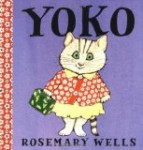
Yoko– written and illustrated by Rosemary Wells
Picture book about teasing and acceptance published by Hyperion Books for Children

When Yoko’s mom packs her favourite things for lunch, Yoko happily boards the school bus and enjoys the morning with her classmates. At lunchtime,
Yoko opened the willow-covered cooler. Inside was her favourite sushi. Tucked in the rice rolls were the crispiest cucumber, the pinkest shrimp, the greenest seaweed, and the tastiest tuna.
When a classmate notices Yoko’s lunch, he remarks, “What’s in your lunch? … Ick! It’s green! It’s seaweed!”
Poor Yoko, before long all of her classmates are laughing about the food in her lunch and she is heartbroken. Fortunately, her teacher, Mrs. Jenkins is alert to the problem and she devises a solution. She announces there will be an International Food Day at Yoko’s school.
Sadly, on the day of the special event, all her classmates avoid Yoko’s sushi. Finally, Timothy gives it a try. He loves the delicious sushi and he’d like to eat it again the following day. Yoko has found a friend. The following day, they push their desks together and enjoy a lovely lunch.
Yoko is a heartwarming picture book about teasing and acceptance. It lends itself well to discussions about tolerance and celebrating our differences. Yoko will appeal to children in preschool and kindergarten.
Anti-bullying children’s books at Amazon.com
Anti bullying children’s books at Amazon.ca
Storytime Standouts’ Anti-Bullying Printables

 Writing paper for kids - Pink Shirt Day
Writing paper for kids - Pink Shirt Day
Pink Shirt Day theme interlined paper for beginning writers.
 Pink Shirt Day Writing Paper #2
Pink Shirt Day Writing Paper #2
Pink Shirt Day-theme interlined writing paper for penmanship practise and story writing.
Follow Storytime Standouts’ board Anti-Bullying Picture Books and Resources on Pinterest.


